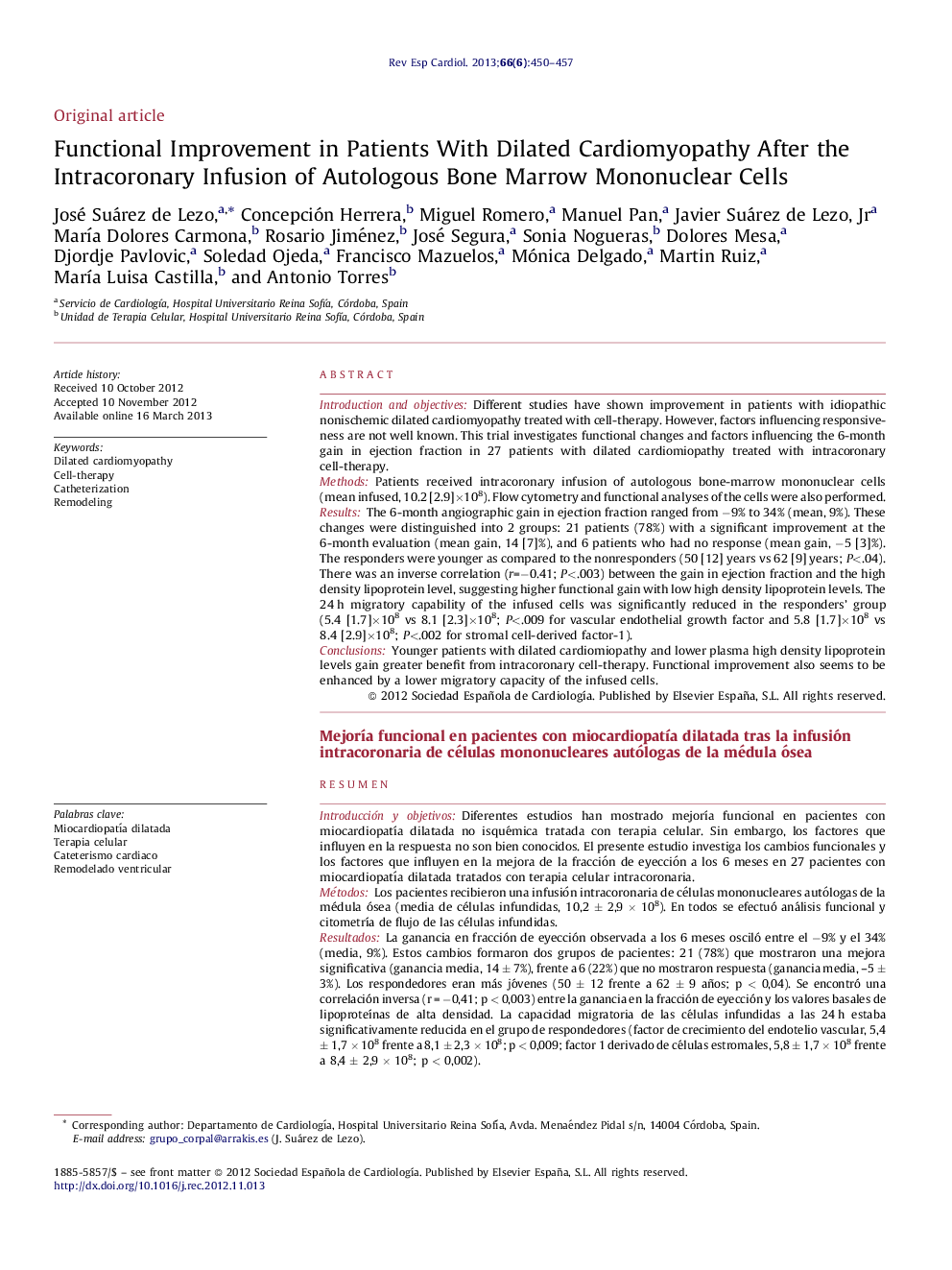| Article ID | Journal | Published Year | Pages | File Type |
|---|---|---|---|---|
| 3017833 | Revista Española de Cardiología (English Edition) | 2013 | 8 Pages |
Introduction and objectivesDifferent studies have shown improvement in patients with idiopathic nonischemic dilated cardiomyopathy treated with cell-therapy. However, factors influencing responsiveness are not well known. This trial investigates functional changes and factors influencing the 6-month gain in ejection fraction in 27 patients with dilated cardiomiopathy treated with intracoronary cell-therapy.MethodsPatients received intracoronary infusion of autologous bone-marrow mononuclear cells (mean infused, 10.2 [2.9]×108). Flow cytometry and functional analyses of the cells were also performed.ResultsThe 6-month angiographic gain in ejection fraction ranged from −9% to 34% (mean, 9%). These changes were distinguished into 2 groups: 21 patients (78%) with a significant improvement at the 6-month evaluation (mean gain, 14 [7]%), and 6 patients who had no response (mean gain, −5 [3]%). The responders were younger as compared to the nonresponders (50 [12] years vs 62 [9] years; P<.04). There was an inverse correlation (r=−0.41; P<.003) between the gain in ejection fraction and the high density lipoprotein level, suggesting higher functional gain with low high density lipoprotein levels. The 24 h migratory capability of the infused cells was significantly reduced in the responders’ group (5.4 [1.7]×108 vs 8.1 [2.3]×108; P<.009 for vascular endothelial growth factor and 5.8 [1.7]×108 vs 8.4 [2.9]×108; P<.002 for stromal cell-derived factor-1).ConclusionsYounger patients with dilated cardiomiopathy and lower plasma high density lipoprotein levels gain greater benefit from intracoronary cell-therapy. Functional improvement also seems to be enhanced by a lower migratory capacity of the infused cells.
ResumenIntroducción y objetivosDiferentes estudios han mostrado mejoría funcional en pacientes con miocardiopatía dilatada no isquémica tratada con terapia celular. Sin embargo, los factores que influyen en la respuesta no son bien conocidos. El presente estudio investiga los cambios funcionales y los factores que influyen en la mejora de la fracción de eyección a los 6 meses en 27 pacientes con miocardiopatía dilatada tratados con terapia celular intracoronaria.MétodosLos pacientes recibieron una infusión intracoronaria de células mononucleares autólogas de la médula ósea (media de células infundidas, 10,2 ± 2,9 × 108). En todos se efectuó análisis funcional y citometría de flujo de las células infundidas.ResultadosLa ganancia en fracción de eyección observada a los 6 meses osciló entre el −9% y el 34% (media, 9%). Estos cambios formaron dos grupos de pacientes: 21 (78%) que mostraron una mejora significativa (ganancia media, 14 ± 7%), frente a 6 (22%) que no mostraron respuesta (ganancia media, –5 ± 3%). Los respondedores eran más jóvenes (50 ± 12 frente a 62 ± 9 años; p < 0,04). Se encontró una correlación inversa (r = −0,41; p < 0,003) entre la ganancia en la fracción de eyección y los valores basales de lipoproteínas de alta densidad. La capacidad migratoria de las células infundidas a las 24 h estaba significativamente reducida en el grupo de respondedores (factor de crecimiento del endotelio vascular, 5,4 ± 1,7 × 108 frente a 8,1 ± 2,3 × 108; p < 0,009; factor 1 derivado de células estromales, 5,8 ± 1,7 × 108 frente a 8,4 ± 2,9 × 108; p < 0,002).ConclusionesLos pacientes más jóvenes con miocardiopatía dilatada y concentración plasmática de lipoproteínas de alta densidad más baja parecen tener mayor beneficio funcional tras la terapia celular. La mejoría funcional también parece aumentada en los pacientes con menor capacidad migratoria de las células infundidas.
